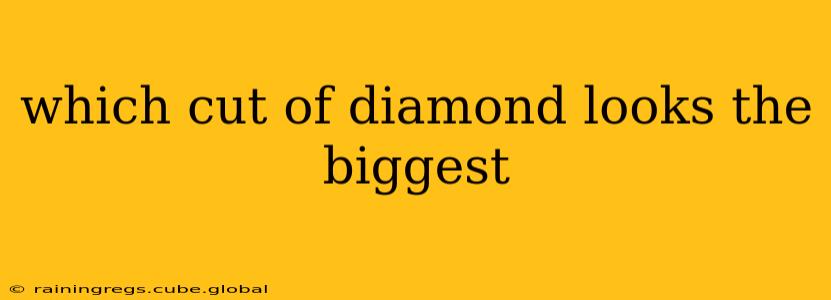Which Cut of Diamond Looks the Biggest?
Choosing a diamond is a significant decision, and understanding how different cuts affect the stone's appearance is crucial. Many factors influence a diamond's perceived size, but the cut is arguably the most impactful. A well-cut diamond will maximize brilliance, fire, and scintillation, making it appear larger than a poorly cut diamond of the same carat weight. So, which cut looks the biggest? The answer isn't straightforward, but we can explore the key players.
Understanding Diamond Cut Grades
Before we dive into which cuts appear largest, it's essential to understand that "cut" in the gemological grading system refers to the proportions, symmetry, and polish of the diamond. These factors directly influence how light interacts with the stone, impacting its brilliance (the overall sparkle), fire (the flashes of color), and scintillation (the sparkle's movement). A diamond with an Excellent or Ideal cut grade will generally appear larger and more vibrant than one with a Poor or Fair cut, even if they have the same carat weight.
Cuts That Often Appear Larger:
Several cuts are known for their ability to maximize light return, giving the illusion of a larger stone:
-
Round Brilliant Cut: This classic cut is a master of brilliance and is often considered the most sparkly. Its symmetrical facets are designed to reflect light back to the viewer, making it appear larger than other cuts of the same carat weight. However, note that a poorly cut round brilliant will appear smaller and duller.
-
Princess Cut: The princess cut's sharp corners and large table (the top facet) can create a significant surface area, giving it a striking presence. This, coupled with a well-executed cut, often makes it appear larger than its carat weight suggests.
-
Oval Cut: This elongated shape naturally stretches the diamond's appearance, creating an illusion of greater size. The oval cut's proportions, when well-executed, contribute to its brilliance, further enhancing this effect.
Cuts That May Appear Smaller:
Some cuts, due to their shape or facet arrangements, might not maximize light return as effectively, leading to a potentially smaller appearance:
-
Emerald Cut: Known for its clean, elegant lines and step-cut facets, the emerald cut emphasizes clarity and color rather than maximum brilliance. The lack of abundant sparkle can make it seem slightly smaller than other cuts of the same carat weight.
-
Asscher Cut: Similar to the emerald cut, the Asscher cut is a step-cut with a distinct geometric shape. Its facets don't maximize brilliance to the same extent as brilliant cuts.
H2: Does the Setting Affect How Big a Diamond Looks?
Yes, absolutely! The setting plays a significant role in how large a diamond appears. A setting with high prongs or thin metal will allow more light to interact with the diamond, making it appear larger. Conversely, a setting with thick metal or low-profile prongs can obscure the diamond, making it seem smaller.
H2: What about the Diamond's Shape?
The shape of a diamond significantly influences its perceived size. Elongated shapes like oval, marquise, and pear cuts often appear larger than round diamonds of the same carat weight because the length creates a visual illusion of greater size. However, this visual effect is entirely separate from the cut grade.
H2: How Can I Make My Diamond Look Bigger?
Choosing the right cut is a starting point, but there are other ways to make your diamond appear larger:
- Select a higher cut grade: An Excellent or Ideal cut will maximize brilliance, making the diamond seem larger.
- Choose an elongated shape: Oval, marquise, and pear cuts often appear larger than round cuts of the same carat weight.
- Opt for a setting that enhances brilliance: Settings with high prongs and minimal metal will allow more light to reflect, making the diamond look bigger.
- Consider the color: A colorless diamond will generally appear larger than a diamond with noticeable color.
In conclusion, while a well-cut round brilliant often maximizes brilliance and perceived size, the oval, and princess cuts also excel at creating an illusion of larger carat weight. The ultimate decision depends on personal preference, but understanding how cut, setting, and shape interact is crucial for choosing a diamond that looks its absolute best. Remember to always prioritize an excellent cut grade for optimal brilliance and sparkle, regardless of the chosen shape.
